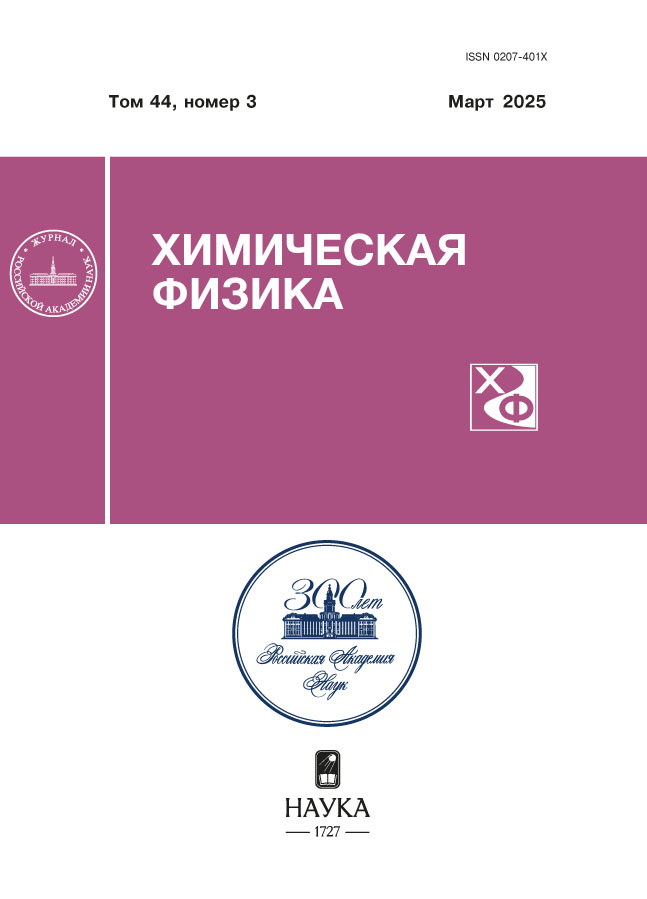Mechanism of effect of the zinc and lead ions on state of the oxidation processes in liposomes from lecithin
- Autores: Mashukova A.V.1, Dubovik A.S.1,2, Shvydkiy V.O.1, Shishkina L.N.1
-
Afiliações:
- Emanuel Institute of Biochemical Physics, Russian Academy of Sciences
- Nesmeyanov Institute of Organoelement compounds, Russian Academy of Sciences
- Edição: Volume 44, Nº 3 (2025)
- Páginas: 97-105
- Seção: Химическая физика экологических процессов
- URL: https://permmedjournal.ru/0207-401X/article/view/679473
- DOI: https://doi.org/10.31857/S0207401X25030108
- ID: 679473
Citar
Texto integral
Resumo
The influence of divalent zinc and lead ions in a wide range of concentrations on the ability of soy lecithin to spontaneous aggregation in water medium, the zeta potential of he formed liposomes, the ability of metal ions to interact with membranes and their participation in the processes of the lipid peroxidation were studied using the method of dynamic light scattering and mathematical processing of UV-spectra of lecithin and its mixtures with metal ions. It has been shown that the scale and direction of the impact of zinc and lead ions corresponds to their biological activity when entering the body. The data obtained and the analysis of the literature allow us to conclude that the effect of zinc ions at high concentrations on the structural state of membranes and their electrophoretic properties and a significant change in the parameters of the lipid peroxidation regulation system in biological objects in the presence of lead ions, even at low doses, are the basis of their toxicity for biological objects.
Palavras-chave
Texto integral
Sobre autores
A. Mashukova
Emanuel Institute of Biochemical Physics, Russian Academy of Sciences
Email: shishkina@sky.chph.ras.ru
Rússia, Moscow
A. Dubovik
Emanuel Institute of Biochemical Physics, Russian Academy of Sciences; Nesmeyanov Institute of Organoelement compounds, Russian Academy of Sciences
Email: shishkina@sky.chph.ras.ru
Rússia, Moscow; Moscow
V. Shvydkiy
Emanuel Institute of Biochemical Physics, Russian Academy of Sciences
Email: shishkina@sky.chph.ras.ru
Rússia, Moscow
L. Shishkina
Emanuel Institute of Biochemical Physics, Russian Academy of Sciences
Autor responsável pela correspondência
Email: shishkina@sky.chph.ras.ru
Rússia, Moscow
Bibliografia
- V.F. Gromov, M.I. Ikim, G.N. Gerasimov, L.I. Trakhtenberg. Russ. J. Phys. Chem. B. 16, 138 (2022). https://doi.org/10.1134/S1990793122010055
- E.V. Stamm, Yu.I. Skurlatov, V.O Shvydkiy et al. Russ. J. Phys. Chem. B. 9, 421 (2015). https://doi.org/10.1134/S1990793115030197
- Yu.I. Skurlatov, E.V. Vichutinskaya, N.I. Zaitseva et al. Russ. J. Phys. Chem. B. 9, 412 (2015). https://doi.org/10.1134/S1990793115030203
- E.V. Stamm, Yu.I. Skurlatov, A.V. Roshchin et al. Russ. J. Phys. Chem. B. 13, 986 (2019). https://doi.org/ 10.1134/S1990793119060095
- V.O. Shvydkiy, E.V. Stamm, Yu.I. Skurlatov et al. Russ. J. Phys. Chem. B. 11, 643 (2017). https://doi.org/10.1134/S1990793117040248
- L.N. Shishkina, M.V. Kozlov, A.Yu. Povkh, V.O. Shvydkiy. Russ. J. Phys. Chem. B. 15, 861 (2021). https://doi.org/ 10.1134/S1990793121050080
- N.Yu. Gerasimov, O.V. Nevrova, I.V. Zhigacheva et al. Russ. J. Phys. Chem. B. 17, 135 (2023). https://doi.org/10.1134/s1990793123010049
- L.N. Shishkina, L.I. Mazaletskaya, M.V. Kozlov et al. Russ. J. Phys. Chem. B. 14, 498 (2020). https://doi.org/ 10.1134/S1990793120030240
- V. Shvydkyi, S. Dolgov, A. Dubovik et al. Chem. J. Moldova. Т. 17(2), 35 (2022). http://dx.doi.org/10.19261/cjm.2022.973
- L.N. Shishkina, M.V. Kozlov, T.V. Konstantinova et al. Russ. J. of Phys. Chem. B. 17, 141 (2023). https://doi.org/ 10.1134/s1990793123010104
- I.V. Kumpanenko, N.A. Ivanova, O.V. Shapovalova et al. Russ. J. of Phys. Chem. B. 16, 917 (2022). https://doi.org/10.1134/s1990793122050050
- A.W. Girotti, J.P. Thomas, J.E. Jordan. J. Free Rad. Biol. & Med. 1, 395 (1985). https://doi.org/10.1016/0748-5514(85)90152-7
- R. Sandhir, K.D. Gill. Biol. Trace elem. Res 48, 91 (1995). https://doi.org/10.1007/BF02789081
- Sh.O. Nuriddinova, A.V. Tsoi, A.S. Sultanbaeva, Kh.N. Akbarkhodzhaeva. ORIENS 3, 214 (2023).
- T.T. Vu, J.C. Fredenburgh, J.I. Weitz. Thromb.Haemost. 109, 421 (2013). https://doi.org/10.1160/TH12-07-0465
- M. Bundschuh, J. Filser, S. Lüderwald et al. Environ. Sci. Eur. 30, 1 (2018). https://doi.org/10.1186/s12302-018-0132-6
- A.V. Lobanova, Yu.S. Chasovskikh. Proc. Intern. conf. Week of russian science. Saratov: Razumovsky University, 2023, P. 1140.
- L.J. Lawton, W.E. Donaldson. Biol. Trace Elem. Res. 28, 83 (1991). https://doi.org/10.1007/BF02863075
- S. Kasperczyk, L. Słowińska-Łożyńska, A. Kasperczyk. Toxicol. Ind. Health 31, 1165 (2015). https://doi.org/10.1177/0748233713491804
- J.B.C. Findlay, W.H. Evans. Biological membranes: a practical approach, Ltd, Oxford, 1987.
- L.N. Shishkina, E.V. Kushnireva, M.A. Smotryaeva. Radiation biology. Radioecology, 44, 289 (2004).
- K.M. Marakulina, R.V. Kramor, Yu.K. Lukanina et al. Russ. J. Phys. Chem. A 90, 286 (2016). https://doi.org/10.1134/S0036024416020187
- E.F. Brin, S.O. Travin. J. Chem. Phys. B. 10, 830 (1991).
- R. Gennis, Biomembranes: Molecular structure and function. (Springer, New York, 1989).
- L.N. Shishkina, M.A. Klimovich, M.V. Kozlov. Pharmaceutical and Medical Biotechn. New Persp, (Nova Science Publishers, New York, 2013).
Arquivos suplementares














